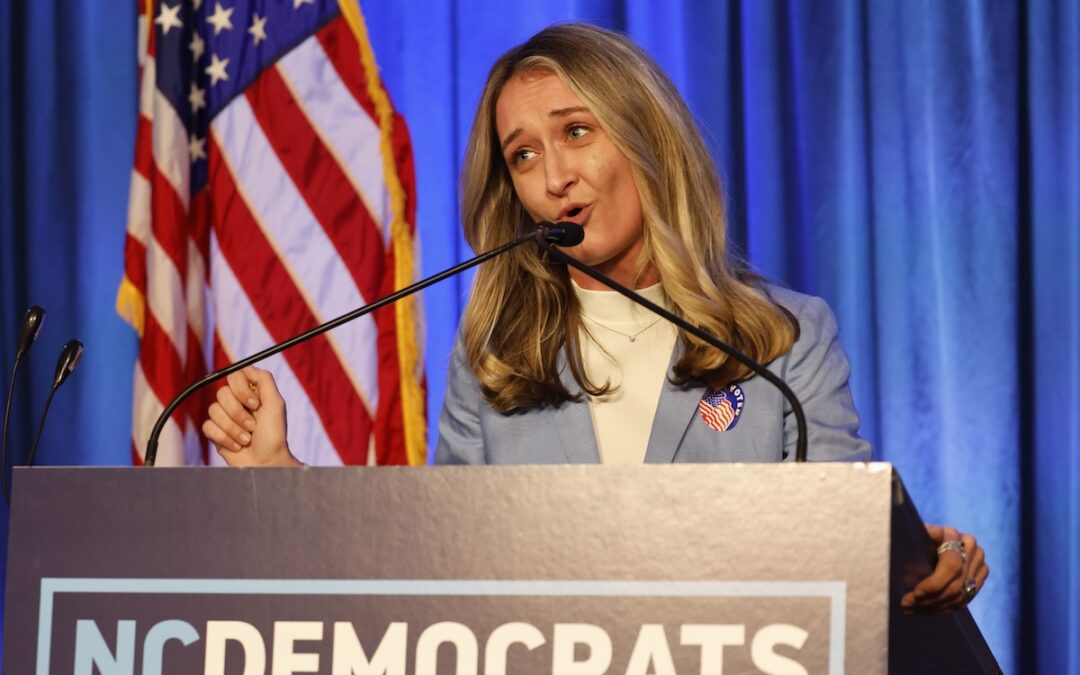
As North Carolina schools reopen, public health leaders will face pressure to require the COVID-19 vaccine. (Image via Shutterstock)
School leaders in NC’s largest system are hoping for a return in the spring semester, but some parents and educators aren’t buying it.
Teachers in North Carolina’s largest public school system in Wake County aren’t happy about a tentative plan to return all students to classrooms in the spring, the head of the local NC Association of Educators chapter says.
“Among high school and middle school teachers, there is concern about having their kids back in the building,” says Kristin Beller, president of the Wake County NCAE. “I don’t find it surprising with [COVID-19] cases rising in North Carolina.”
As of Monday, total cases in North Carolina topped 336,000 with over 26,000 in Wake County. The governor’s office has created a classification system for coronavirus transmission that places each county in one of three categories, red for critical spread, orange for substantial spread, and yellow for significant spread. Wake County is yellow with a 5.6% positive rate spread over 14 days and a correspondingly low impact on county hospitals.
Still, NC is seeing record numbers of new infections this month, setting a new high of more than 4,500 new confirmed cases Sunday. Indeed, transmission has been more or less on a steep incline since September.
But, citing academic concerns, Wake County school officials say they want to return students to classrooms in the second semester in January, approving a plan last week that would not only offer in-person learning to K-5 students, but clear a rotation of middle- and high-school students as well. Under their plan, students would be in alternating three-week groups, with two weeks of virtual class and one week of in-person class.
As of Friday, the state was reporting two ongoing COVID clusters in Wake County K-12 schools, although both were in private Christian schools. The district had reportedly counted between 40 to 50 new cases in the school system between Oct. 26 and Nov. 10,
Only one Wake board member voted against the second semester plan. According to WRAL, board member Jim Martin said the plan did not follow the “three Ws” recommended by the NC Department of Health and Human Services: Wear a mask, wait 6 feet apart and wash your hands.
“I do not see that the data supports that we should not follow all three Ws,” Martin said at the meeting.
Due to the large class sizes coming this spring, Wake County Public School System also informed families last week that social distancing of 6 feet might have to be replaced by a 3-foot buffer.
Beller questioned the wisdom of watering down safety precautions, particularly when the safety of school rooms is being touted as a reason to fully reopen classrooms in the spring.
She noted that health officials have said there is growing evidence that young children don’t spread coronavirus easily, and it is therefore safe for them to be in school.
“The actual guidance right now is that you are as distant as possible in K through 3,” Beller said. “When teachers pushed back and said, ‘Wait, the three Ws means 6 feet away,’ that’s where that 3 feet came in. ‘Oh, there’s research that says three feet might be okay.’”
“Age 10 is the age where things start crossing over,” Beller added. “At that age, their response to the virus is more similar to adults than it is to a child.”
Scott Hanson, the father of two 10th-grade sons in Raleigh, won’t be participating in a return to the classroom.
He told Cardinal & Pine this week that he enrolled his children in North Carolina Virtual Academy, a publicly-funded online school, at the start of the 2020-2021 school year. He’s since enrolled them for the spring semester too.
“We told [our sons] that all of their friends would be taking online classes too — they just didn’t know it yet,” Hanson said. “Sure enough, the whole county was forced online to start the year.”
“Soon afterward, we got an email that someone connected with their [former] school had tested positive.”
What’s behind the new class plan?
Academic concerns are the heart of the push to return students to classrooms. Twenty-five per cent of district middle and high school students have failed at least one class during remote learning.
Administrators also said that the slump could be due to lower attendance— 8.8% of students had four or more absences in the first quarter, compared to 5.8% last year – that coincides with remote learning.
The results would seem to confirm much of the research about virtual education, which suggests it is generally less effective than classroom instruction although better than no class at all. However, those studies have found remote learning could be especially problematic for children who were already struggling.
Most educators who’ve criticized in-person learning during the pandemic have acknowledged virtual learning’s shortfalls, but suggested that it has to be weighed against the safety of children and staff.
Beller, the Wake NCAE president, said it’s short-sighted to assume that only remote learning is the cause of these problems.
She asked if there might be other factors impacting a student’s learning, many that could be exacerbated by the pandemic, including a parent’s job loss, a transition in living conditions or medical issues.
“Let’s dig in and find out what are the specific patterns and trends that are happening within that big red flag of the 25% failure rate,” Beller said.
Beller said she’d like to see a breakdown of where the educational failures are happening. Are they in a specific content area? Is there a trend in a certain grade level?
At the same time, she said there are students who are responding far more positively to online learning than they ever did to physical classrooms.
“You cannot generalize and say that online learning as a whole is not working for students,” she said. “It’s more complex than that.”
A Stanford University study published in February 2017 suggests that a single approach to online teaching may not yield the best outcome for everyone in class. By recognizing cultural differences among class participants, instructors can tailor teaching strategies to specific students.
Further research by Stanford Assistant Professor Chuck Eesley says team-based learning increases course completion 16-fold compared to individual learners. Social learning such as discussion boards drives higher student engagement and team-based assignments foster a culture of shared accountability, Eesley found.
Hypocritical policies?
Educators in Wake County seemed particularly angered by the circumstances surrounding last week’s school board meeting, which was limited to 10 people due to Gov. Roy Cooper’s executive order capping the number of people at indoor gatherings.
“I am so confused,” educator Siobhan Scappino wrote on Twitter. “So, we can pack WCPSS buildings with staff and fill classrooms full of students with no social distancing required… but when it comes to their meetings, they want to limit the exposure.”
“It seems that their lives are more important than those of the students and teachers being crammed back into school buildings,” teacher Sherri Laupert wrote.
But Beller pointed out that the board was acting within the governor’s restrictions. While she said she believed the board should be held accountable, it would be unwise to place the blame for unsafe classrooms, teachers and students on the Wake County Board of Education’s actions.
“When there are 115 school districts in North Carolina who all have to make their own individual decisions, I don’t think it’s fair to say if we have a tragedy in Wake County, that it is the fault of the school board,” she said.
Beller noted that the board is not acting in isolation. The federal government could have released guidance for schools, she said, but it has chosen not to.
“COVID is claiming lives at an alarming rate all across our nation,” Beller said. “It’s not because of one governing body making a specific decision. It’s because our country as a whole has not addressed the pandemic in an effective way.”
Regardless, some parents like Hanson say it would be irresponsible to send students and teachers back to classrooms given current infection trends, and the rates we might see as the winter progresses.
“Wake County can say it’s opening school all it wants,” Hanson said. “The virus is calling the shots.”
Politics

Op-Ed: North Carolina Republicans are working overtime to restrict abortion even more. But we can stop them at the ballot box.
When I think about abortion access in North Carolina, I think about lying there on a hospital bed after I was sexually assaulted, with sympathetic...

Mark Robinson and Michele Morrow pose a threat to women and kids, warns Anderson Clayton
The state’s Democratic Party chair believes North Carolinians deserve better than a six-week abortion ban and the defunding of public schools that...
Local News

The 5 most believable UFO sightings ever reported in North Carolina
Read about five alien encounters that may forever remain unexplained. When you think of the most common places where you might hear a UFO sighting...

Good News Friday: It’s a good day to be a fan of the NC State Wolfpack
The men's and women's teams will compete for a national championship in college basketball this weekend. Plus: How to watch the solar eclipse, and...




